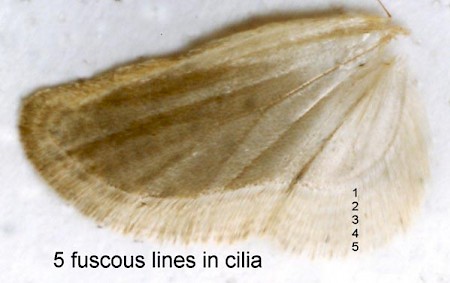
32.019 BF689
Agonopterix ciliella
(Stainton, 1849)
Wingspan 19 -24 mm.
Agonopterix ciliella is widespread throughout Britain, flying at night in suitable weather from August to May, and sometimes coming to light. It can be distinguished from the commoner A. heracliana by the five brownish lines in the cilia near the base of the hindwing where heracliana only has one.
Larvae feed from June to September on a variety of umbelliferous plants.
- Larva: (description Ian F. Smith):
Foodplants: June - September in spun or rolled leaves of Angelica sylvestris, Aegopodium podagraria, Heracleum sphondylium, Daucus, Selinum, Silaum, Chaerophyllum, Pastinaca, Anthriscus, Meum orPeucedanum palustre.
Early instar
Length: 11 mm described
Head: Black or pitchy black.
Prothorax (T1): Anterior margin whitish. Prothoracic shield black or pitchy black, divided by a fine light medial line.
Body: Dorsally light greyish green with darker dorsolateral line. Contractile dorsal vessel shows as a darker green dorsal line. Ventrally greenish white.
Pinacula: Black.
Setae: Blackish.
Anal plate: Greenish white.
Prolegs: Concolorous with abdomen.
Late instar
Length: 19 mm described. (MBGBI; 20 - 25 mm final instar.)
Head: Black with a large brown ochre subdorsal patch on each epicranial sphere. Frons and mouthparts brownish.
Prothorax (T1): Anterior margin whitish. Dorsally, the prothoracic shield is amber transparent, appearing brownish amber when head withdrawn, and greenish amber when head extended. Laterally, the prothoracic shield is opaque black. Divided by fine transparent medial line.
Thoracic legs: Yellowish brown. (MBGBI; greenish brown).
Body: Light green with dark green dorsal and dorsolateral lines.
Spiracles: Pitchy peritreme.
Pinacula: Black on segments T2 and T3. On other segments, black centrally, concolorous peripherally. The area of black diminishing towards posterior of abdomen, and on segments A9 and A10 reduced to black setal spot.
Setae: Blackish or, under strong light and magnification, dark reddish brown.
Anal plate: Yellowish green.
Prolegs: Concolorous with venter. Planta paler. Crochets pale brown.
Similar species: On Daucus the larva of A. rotundella can be distinguished by its smaller size, 10 - 12 mm final instar, and finer pinacula on T2 and T3, but larvae should be reared for confirmation.

 UKMoths
UKMoths 




